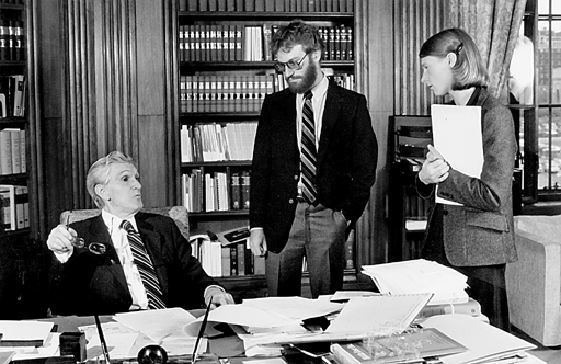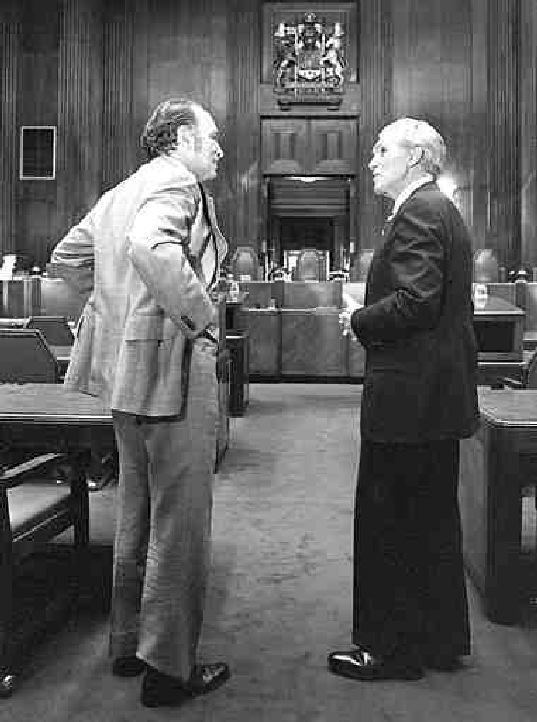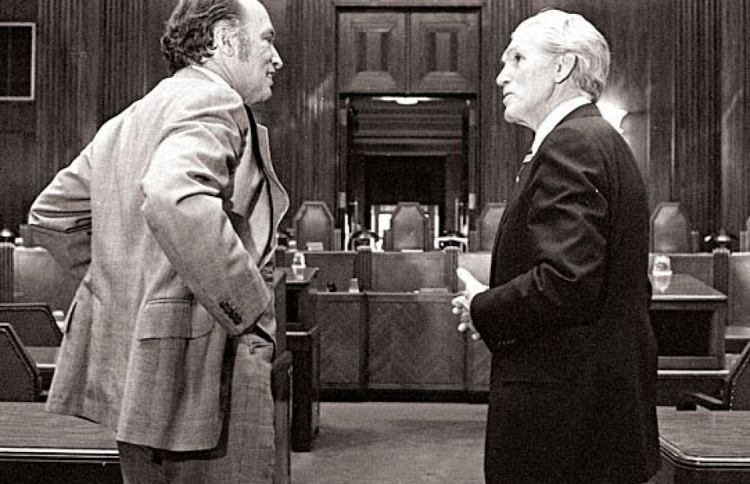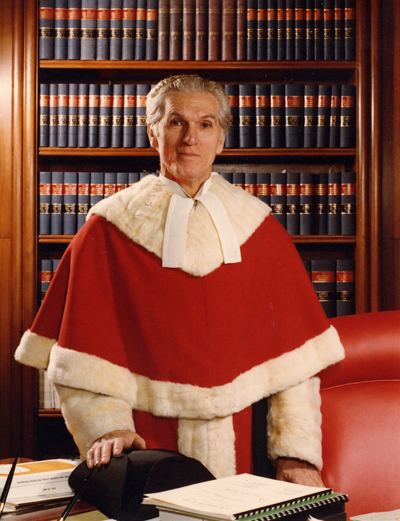Preceded by Gerald Fauteux Role Lawyer | Name Bora Laskin Preceded by Gerald Fauteux Spouse(s) Peggy Tenenbaum | |
 | ||
Education | ||
Angelique eaglewoman dean of lakehead s bora laskin faculty of law
Bora Laskin, (October 5, 1912 – March 26, 1984) was a Canadian lawyer, academic and judge. He served on the Supreme Court of Canada for fourteen years, including a decade as the 14th Chief Justice of Canada.
Contents
- Angelique eaglewoman dean of lakehead s bora laskin faculty of law
- Senator Murray Sinclair Bora Laskin Faculty of Law
- Early life and family
- Education
- Legal career
- Ontario Court of Appeal
- Supreme Court of Canada
- Judicial philosophy
- The Patriation Reference
- Death
- Recognition
- Honorary degrees
- References

Senator Murray Sinclair Bora Laskin Faculty of Law
Early life and family

Laskin was born in Fort William, Ontario (now Thunder Bay), the son of Max Laskin and Bluma Zingel. His brother, Saul Laskin, went on to become the first mayor of Thunder Bay. His other brother, Charles, was a shirt designer and manufacturer.

Laskin married Peggy Tenenbaum. The couple had two children: John, who followed in his father's footsteps and became a judge at the Ontario Court of Appeal, and Barbara. His grandson (the son of his daughter) carries on his name. His nephew John B. Laskin is a prominent commercial lawyer in Toronto.
Education

Laskin was educated as a lawyer at Osgoode Hall Law School. He initially studied at the University of Toronto, earning a Bachelor of Arts in 1933. He received the degrees of Master of Arts in 1935. He then earned a Bachelor of Laws from the University of Toronto in 1936.

While at the University of Toronto, he was a member of Sigma Alpha Mu fraternity. In 1937, he received a Master of Laws from Harvard Law School. He earned a gold medal at both the University of Toronto Law School and at Harvard Law School.
Legal career
Despite his superior academic record, Laskin, who was Jewish, was unable to find work at any law firm of note, because of the anti-Semitism that pervaded the English-Canadian legal profession at the time. As a result, his first job after graduating was writing headnotes (i.e., article synopses) for the Canadian Abridgement, a legal research tool.
In order to be called to the bar, it was required that he serve articles with a lawyer who was already a member of the bar. He had trouble finding a lawyer who would serve as his principal, because non-Jewish lawyers would not accept Jewish students. Through connections, he eventually found a young Jewish lawyer, Sam Gotfrid, who was willing to sign as his principal, but Gotfrid was himself only just starting out and could not provide Laskin with any work or salary. A year into his articles, Laskin found a non-Jewish lawyer, W.C. Davidson, who was willing to take him as an articling student, and he finished his articles with Davidson. In later years, Laskin would say that he articled with Davidson, not mentioning his initial start with Gotfrid.
Ultimately, Laskin decided to pursue his career in academia. From 1940 to 1965 he taught at the University of Toronto (except for the period 1945 - 1949 when he taught at Osgoode Hall Law School). For twenty-three years he served as associate editor of Dominion Law Reports and Canadian Criminal Cases. He also wrote Canadian Constitutional Law and many other legal texts. His interests were in labour law, constitutional law, and human rights. He was a founding member of the Canadian Civil Liberties Association.
Ontario Court of Appeal
Laskin's career on the bench began in 1965 with his appointment to the Ontario Court of Appeal. While on the Court of Appeal, Laskin gave a decision in a divorce case, upholding the constitutional authority of the federal Parliament to include the right to spousal support under the Divorce Act. Laskin held that spousal support was ancillary to Parliament's constitutional jurisdiction over divorce under the Constitution Act. When the Supreme Court of Canada considered the same issue three years later, it unanimously reached the same conclusion, citing Laskin's decision from the Ontario Court of Appeal.
Supreme Court of Canada
On March 19, 1970 he was appointed by Prime Minister Pierre Trudeau to the Supreme Court, becoming the first Jewish justice to sit on that Court. Three years later, on December 27, 1973, Trudeau appointed Laskin as Chief Justice, a position he held until his death in 1984.
Laskin's appointment as Chief Justice generated some controversy. He was the second-most junior justice on the Court, having served for only three years. The long-standing tradition was that on the retirement of the Chief Justice, the senior puisne justice on the Court would be appointed. Since the creation of the Court in 1875, this practice had been followed except on two occasions, in 1906 and 1924, when the senior puisne justices had been passed over. By that tradition, the appointment as Chief Justice would have gone to Justice Ronald Martland, who had been on the Court for fifteen years. When Prime Minister Trudeau appointed Laskin, it was said that Justice Martland had been given very little notice that he would be passed over, and was upset by it. The Finance Minister, John Turner, was rumoured to be furious at the departure from the traditions of the Court.
Judicial philosophy
Laskin was a liberal jurist who often found himself on the minority side of decisions. His specialty was labour law and constitutional law and he had a reputation as a civil libertarian.
On matters of federalism under the Constitution Act, 1867, Laskin has been considered the most aggressive supporter of the federal powers of any justice since Confederation. This made for a stark contrast with fellow Justice Jean Beetz, who was known as one of the strongest supporters of provincial powers under the Constitution.
In his earlier years on the Supreme Court, Laskin was frequently in dissent. During the 1970s, Laskin frequently joined with Justice Spence and Justice Dickson on cases involving civil liberties, often in dissent from the more conservative majority on the Court. The grouping was colloquially referred to as the "LSD connection."
Laskin often took a position that was later adopted by a majority of the Court. Among his most famous dissents was his opinion in Murdoch v. Murdoch, where he was the sole judge who would have ruled in favour of a wife's application for an equal division of property acquired during the course of the marriage. The outcome of the case was highly controversial. It triggered reforms to matrimonial laws across the country, adopting Laskin's view of property equality between husband and wife. Years later, Laskin said that the position he took in this case was the likely cause of his promotion to Chief Justice over the more senior Ronald Martland.
The Patriation Reference
Laskin presided over a number of landmark constitutional cases, most notably the 1981 Patriation Reference, which considered Pierre Trudeau's attempt to have the federal government unilaterally patriate the Constitution of Canada without the consent of the provinces. The case was a consolidated appeal of three provincial references, from Quebec, Manitoba and Newfoundland. By a 7-2 division, a majority of the Court held that Parliament had the legal authority to act unilaterally. However, by a division of 6-3, the Court also held that unilateral federal action would violate a constitutional convention that had emerged since Confederation, requiring substantial provincial agreement on constitutional amendments. Laskin was one of the judges in the majority on the issue of Parliament's legal authority to act unilaterally, but was one of the three dissenting judges who would have held that there was no constitutional convention restricting Parliament's power to act unilaterally.
As a result of the decision in the Patriation Reference, Trudeau decided to begin a new round of negotiations with the provinces, which resulted in the patriation of the Constitution from Britain being agreed to by all provinces save Quebec. Historian Frederic Bastien suggests that Laskin may have violated the constitutional separation of powers by discussing the deliberations of the Court with politicians, casting doubt on the legitimacy of the decision. However, surviving participants in the Reference process do not think that the allegations, even if true, undercut the validity of the Court's decision. Other scholars said that the patriation process violated judicial independence.
Death
Laskin was in poor health the last few years of his life, and died in office on March 26, 1984, at the age of 71 from pneumonia. Two weeks before his death, on March 13, 1984, he was made a Companion of the Order of Canada.
Prime Minister Trudeau offered a state funeral, but the family declined because Laskin "liked things very simple." Instead, Laskin lay in state in the Great Hall of the Supreme Court building, prior to a simple funeral ceremony in Ottawa and interment at Holy Blossom Memorial Park in Toronto. His brother Saul Laskin was later buried beside him.
Recognition
Honorary degrees
Bora Laskin Received Honorary Degrees from Many Canadian and International Universities, These Include
